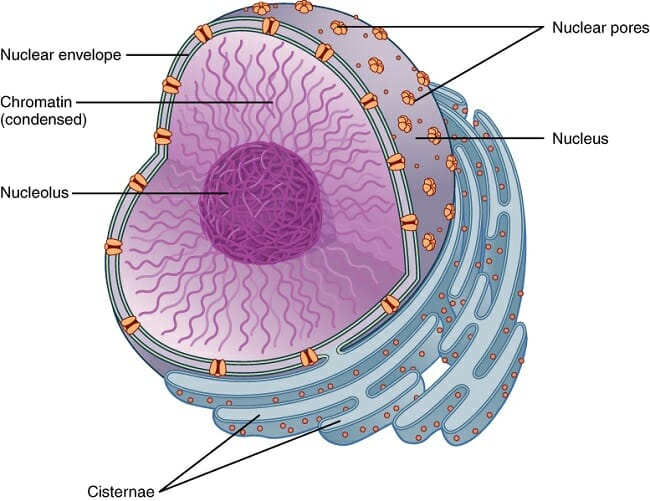Class 10 - Science
Chapter 13 - Magnetic Effects of Electric Current
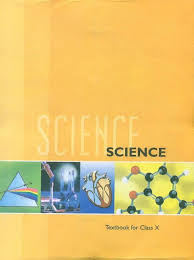
Top Block 1
Question : 1 Why does a compass needle gets deflected when brought near a bar magnet?
Answer :
A compass needle is, in fact, a small bar magnet. If this is brought near another bar magnet, the like poles repel and the needle gets deflected.
Question : 2 Draw magnetic field lines around a bar magnet?
Answer :
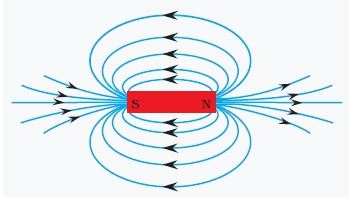
Question : 3 List the properties of magnetic lines of force.
Answer :
a) Magnetic lines are directed from the north pole towards the south pole.
b) They do not cross each other.
c) They are more crowded near the poles than at any other region in the field.
d) They are closed curves.
e) In the uniform magnetic field, the lines of force are parallel to one another.
Question : 4 Why don’t two magnetic lines of force intersect each other?
Answer :
No two field-lines are found to cross each other. If they did, it would mean that at the point of intersection, the compass needle would point towards two directions, which is not possible.
Question : 5 Consider a circular loop of wire lying in the plane of the table. Let the current pass through the loop clockwise. Apply the right-hand rule to find out the magnetic field inside and outside the loop.
Answer :
At every point of a current –carrying loop, the concentric circles representing the magnetic field around it would become larger and larger as we move away from the wire. By the time we reach at the center of the circular loop, the arc of these big circles would appear as straight lines.
Question : 6 The magnetic field in a given region is uniform. Draw a diagram to represent it.
Answer :
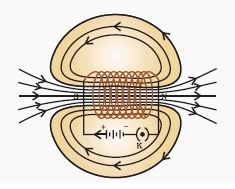
Mddle block 1
Question : 7 The magnetic field inside a long straight solenoid-carrying current
a) is zero
b) decreases as we move towards its end
c) increases as we move towards its end
d) is the same at all points
Answer :
d) is the same at all points
Question : 8 Which of the following property of a proton can change while it moves freely in a magnetic field? a) Mass b) Speed c) Velocity d) Momentum
Answer :
c) Velocity d) Momentum.
Question : 9 (a) Current in rod AB is increased?
(b) A stronger horseshoe magnet is used?
(c) Length of the rod AB is increased?
Answer :
(a) If the current in rod AB is increased, the displacement of rod AB will not be affected.
(b) If a stronger horseshoe magnet is used, force is exerted and hence the displacement increases.
(c) If the length of the rod AB is increased there is no change in the displacement of the rod AB.
Question : 10 A positively-charged particle projected towards west is deflected towards north by a magnetic field. The direction of the magnetic field is
a) Towards south b) Towards east c) Downward d) Upward
Answer :
b) Towards east.
Question : 11 State Fleming’s left-hand rule.
Answer :
Fleming’s left-hand rule states that, stretch the thumb, fore finger and middle finger of the left hand such that they are mutually perpendicular. If the first finger points in the direction of magnetic field and the second finger in the direction of current, then the thumb will point in the direction of motion or the force acting on the conductor.
Question : 12 What is the principle of an electric motor?
Answer :
Principle of an electric motor:
The working of the electric motor is based on the mechanical effect of an electric current. A conductor carrying a current placed in a magnetic field experiences a mechanical force.
In the motor, when a current is passed through a rectangular coil of wire placed in a magnetic field, the coil rotates continuously.
Question : 13 What is the role of the split ring in an electric motor?
Answer :
In electric motor, the split ring acts as a commutator. A device that reverses the direction of flow of current through a circuit is called a commutator. The reversal of current also reverses the direction of force acting on the two arms AB and CD.
Question : 14 Explain different ways to induce current in a coil.
Answer :
Current can be induced in a coil either by moving it in a magnetic field or by changing the magnetic field around it. The induced current is found to be the highest when the direction of motion of the coil is at right angles to the magnetic field. The process, by which a changing magnetic field in a conductor induces a current in another conductor, is called electromagnetic induction.
Question : 15 State the principle of an electric generator.
Answer :
A generator is also known as a dynamo. It is a device used to convert mechanical energy in to electrical energy. The mechanical energy is used to rotate a conductor in a magnetic field to produce electricity. It is an application of electromagnetic induction. An A.C generator generates an alternating current. A D.C generator is used to deliver a current, which flows in the same direction.
Question : 16 Name some source of direct current.
Answer :
The source of direct current is a split-ring type commutator, one brush is at all times in contact with the arm moving up in the field, while the other is in contact with the arm moving down. Thus a unidirectional current is produced.
Question : 17 Which sources produce alternating current?
Answer :
The sources which produce alternating current is a permanent magnet called the field magnet, armature, slip ring and carbon brushes. After every half rotation the polarity of the current in the respective arms changes. Such a current, Which changes direction after equal intervals of time, is called an alternating current.
Question : 18 A rectangular coil of copper wires is rotated in a magnetic field. The direction of the induced current changes once in each:
a) Two revolutions b) One revolution c) Half revolutions d) One-fourth revolutions.
Answer :
b) One revolution.
Question : 19 Name two safety measures commonly used in electric circuits and appliances.
Answer :
The use of an electric fuse prevents the electric circuits and appliance from a possible damage by passing the flow of unduly high electric current. The Joule heating that takes place in the fuse melts it to break the electric circuit.
Question : 20 An electric oven of 2 KW power rating is operated in a domestic electric circuit (220 V) that has a current rating of 5 A. What result do you expect? Explain.
Answer :
V = 220 V, I = 5 A
Power, P = VI
P = 220 × 5
P = 1100 W
Therefore, power P = 1100 W = 1.1 KW
Therefore, an electric oven of 2 KW power rating cannot be operated in a domestic electric circuit (220 V) that has a current rating of 5 A because electric oven has higher power than the power of the electric circuit.
Question : 21 What precaution should be taken to avoid the overloading of domestic electric circuits?
Answer :
Fuse is the most important safety device, to avoid the overloading of domestic electric circuits.
Too many appliances should not be connected to a single socket.
Question : 22 Which of the following correctly describes the magnetic field near a long straight wire?
(a) The field consists of straight lines perpendicular to the wire.
(b) The field consists of straight lines parallel to the wire.
(c) The field consists of radial lines originating from the wire.
(d) The field consists of concentric circles centred on the wire.
Answer :
(d) The field consists of concentric circles centred on the wire.
Question : 23 The phenomenon of electromagnetic induction is
(a) the process of charging a body.
(b) the process of generating magnetic field due to a current passing through a coil.
(c) producing induced current in a coil due to relative motion between a magnet and the coil.
(d) the process of rotating a coil of an electric motor.
Answer :
(c) producing induced current in a coil due to relative motion between a magnet and the coil.
Question : 24 The device used for producing electric current is called a
(a) generator.
(b) galvanometer.
(c) ammeter.
(d) motor.
Answer :
(a) generator.
Question : 25 The essential difference between an AC generator and a DC generator is that:
(a) AC generator has an electromagnet while a DC generator has permanent magnet.
(b) DC generator will generate a higher voltage.
(c) AC generator will generate a higher voltage.
(d) AC generator has slip rings while the DC generator has a commutator
Answer :
(d) AC generator has slip rings while the DC generator has a commutator.
Question : 26 At the time of short circuit, the current in the circuit
(a) reduces substantially.
(b) does not change.
(c) increases heavily.
(d) vary continuously.
Answer :
(c) increases heavily.
Question : 27 State whether the following statements are true or false.
Answer :
(a) An electric motor converts mechanical energy into electrical energy – false.
(b) An electric generator works on the principle of electromagnetic induction – true
(c) The field at the centre of a long circular coil carrying current will be parallel straight lines – true.
(d) A wire with a green insulation is usually the live wire of an electric supply – true.
Question : 28 List three sources of magnetic fields.
Answer :
a) Magnetic field due to a current through a straight conductor.
b) Magnetic field due to a current in a solenoid.
c) Magnetic field due to a current through a circular loop.
Question : 29 How does a solenoid behave like a magnet? Can you determine the north and the south poles of a current-carrying solenoid with the help of a bar magnet? Explain.
Answer :
A coil of many circular turns of insulated copper wire wrapped closely in the shape of the cylinder is called a solenoid. The pattern of the magnetic field lines around a current- carrying solenoid is shown in this figure. In fact, one end of the solenoid behaves as a magnetic north pole, while the other behaves as the south pole. The field lines inside the solenoid are in the form of parallel straight lines. This indicates that the magnetic field is the same at all points inside the solenoid. That is, the field is uniform inside the solenoid.
A strong magnetic field produced inside a solenoid can be used to magnetise a piece of magnetic material, like soft iron, when placed inside the coil. The magnet so formed is called an electromagnet.
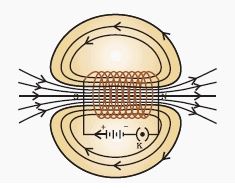
Question : 30 When is the force experienced by a current-carrying conductor placed in a magnetic field the largest?
Answer :
The force experienced by a current-carrying conductor placed in a magnetic field is largest provided when the direction of current is at right angles to the direction of the magnetic field.
Question : 31 Imagine that you are sitting in a chamber with your back to one wall. An electron beam, moving horizontally from back wall towards the front wall, is deflected by a strong magnetic field to your right side. What is the direction of magnetic field?
Answer :
The direction of magnetic field is towards west.
Question : 32 Draw a labelled diagram of an electric motor. Explain its principle and working.What is the function of a split ring in an electric motor?
Answer :
A motor is a device that converts the electrical energy into mechanical energy.
Principle
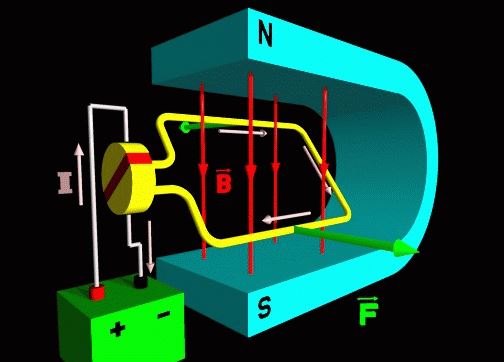
Working
Suppose the coil ABCD is initially at a horizontal position. When the switch is in ON position the current enters the coil through the carbon brushes and the half ring ‘A’ of the commutator. The current flows in the direction DCBA and leaves via the half ring ‘B’. In the side PQ of the coil, the direction is from Q to P towards the south and the direction of the magnetic field is from the N to S pole towards the east. So, by applying Fleming’s left hand rule, we find that it will experience a force in upward direction. Similarly, the side SR of the coil will experience a downward force. Thus we have two parallel wires experiencing forces in opposite directions. They form a couple tending to rotate the coil in the anticlockwise direction.
When the coil goes beyond the vertical position, the two commutator half rings automatically changes contact from one brush to the other. This reverses the direction of current through the coil which, in turn, reverses the direction of forces acting on the two sides of the coil. The sides of the coil are interchanged, but rotate in the same anticlockwise direction. This process is repeated again and again and the coil continues to rotate as long as the current is passing.
Question : 33 Name some devices in which electric motors are used.
Answer :
Electric fans, refrigerators, mixers, washing machines, computers, MP3 players etc are some devices in which electric motors are used.
Question : 34 A coil of insulated copper wire is connected to a galvanometer. What will happen if a bar magnet is
(i) pushed into the coil, (ii) withdrawn from inside the coil, (iii) held stationary inside the coil?
Answer :
(i) A deflection is observed in the galvanometer due to the induced current because of the changing magnetic flux (increasing) through the turns of the coil connected to the galvanometer.
(ii) A deflection is again observed in the galvanometer, as when it is pulled out, the flux linked with the coil due to the bar magnet decreases. Hence a current flows in the coil to reduce the change in flux. The deflection can be observed in the opposite direction as compared with the previous case.
(iii) No deflection is observed in the galvanometer. The flux linked with the coil due to the magnetic field is at a constant. Hence no current is induced due to the bar magnet.
Question : 35 Two circular coils A and B are placed closed to each other. If the current in the coil A is changed, will some current be induced in the coil B? Give reason.
Answer :
Yes, if the current in the coil A is changed, then some current will be induced in the coil B because due to the change in the magnetic field effect around the coils.
Question : 36 State the rule to determine the direction of a
(i) magnetic field produced around a straight conductor-carrying current,
(ii) force experienced by a current-carrying straight conductor placed in a magnetic field which is perpendicular to it, and
(iii) current induced in a coil due to its rotation in a magnetic field.
Answer :
(i) Right-hand thumb rule
Imagine that we are holding a current carrying straight conductor in the right hand such that the thumb points towards the direction of current. Then our fingers will wrap around the conductor in the direction of the field lines of the magnetic field. This is known as Right-hand thumb rule.
(ii) Fleming’s left-hand rule
Fleming’s left-hand rule states that, stretch the thumb, fore finger and middle finger of the left hand such that they are mutually perpendicular. If the first finger points in the direction of magnetic field and the second finger in the direction of current, then the thumb will point in the direction of motion or the force acting on the conductor.
(iii) Fleming’s right-hand rule
If the thumb and the first two fingers of right hand are held at right angles to each other, with the Forefinger held in the direction of the field, and the thumb in the direction of motion, the induced current I flows in the direction of the middle finger.
Question : 37 Explain the underlying principle and working of an electric generator by drawing a labelled diagram. What is the function of brushes?
Answer :
A C. generator
“A C. generator” means “Alternating Current generator”.
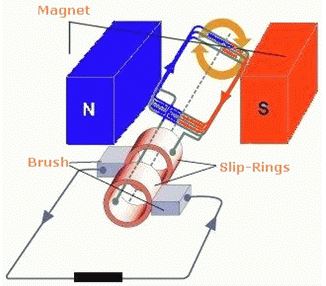
Construction of an A. C. generator
A simple A. C. generator consists of a rectangular coil ABCD that can be rotated rapidly between the poles N and S of a strong horseshoe type magnet M. The coil is made of a large number of turns of insulated copper wire. The ends A and D of the rectangular coil are connected to two circular pieces of copper metal called slip rings R1 and R2. As the slip rings R1 and R2 rotate with the coil, the two pieces of carbon called brushes, B1 and B2, keep contact with them. So, the current produced in the rotating coil can be tapped out through slip rings into the carbon brushes. From the carbon brushes B1 and B2 we take the current into various electrical appliances like radio, T. V., electric iron, bulbs, etc. But in this figure, we have shown only a galvanometer G connected the two carbon brushes.
Working of an A. C. generator
Suppose that the generator coil ABCD is initially in the horizontal position. Again suppose that he coil ABCD is being rotated in the anticlockwise direction between the poles N and S of a horseshoe type magnet.
(i) As the coil rotates in the anticlockwise direction, the side AB of the coil moves down cutting the magnetic lines of force near the N-pole of the magnet, and side CD moves up, cutting the lines of force near the S-pole of the magnet. Due to this, induced current is produced in the sides AB and DC of the coil. On applying Fleming’s right hand rule to the side AB and DC of the coil, we find that the currents are in the direction B to A and D to C respectively. Thus, the induced currents in the two sides of the coil are in the same direction, and we get an effective induced current in the direction BADC.
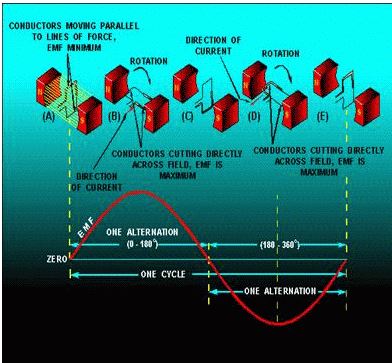
After every half revolution, each side of the generator coil starts moving in the opposite direction in the magnetic field. The side of the coil which was initially moving downwards in a magnetic field, after half revolution, it starts moving in opposite direction – upwards. Similarly the side of coil which was initially moving upwards, after half revolution, it starts moving downwards. Due to the change in the direction of motion of the two sides of the coil in the magnetic field after every half revolution, the direction of current produced in them also changes after every half revolution.
D. C. generator
“D. C. generator” means “Direct Current generator”.
That is, a D. C. generator produces direct current and not alternating current. We will now describe the construction and working of D. C. generator or D. C. Dynamo.
Construction of a D. C. generator
A simple D. C. generator consists of a rectangular coil ABCD which cab be rotated rapidly between the poles N and S of a strong horse-shoe type magnet M. The generator coil is made of a large number of turns of insulated copper wire. The two ends of the coil are connected to the two copper half rings (or split rings) R1and R2 of a commutator. There are two carbon brushes B1 and B2 which press lightly against the two half rings. When the coil is rotated, the two half rings R1 and R2 touch the two carbon brushes B1 and B2 one by one. So the current produced in the rotating coil can be tapped out through the commutator half rings into the carbon brushes. From the carbon brushes B1 and B2, we can take the current into the various electrical appliances like radio, T. V., electric iron, bulbs, etc. But in this figure, we have shown only a galvanometer G connected between the two carbon brushes. The galvanometer is a current detecting and current measuring instrument.
Working of a D. C. generator
Suppose that the generator coil ABCD is initially in the horizontal position. Again suppose that he coil ABCD is being rotated in the anticlockwise direction between the poles N and S of a horseshoe type magnet.
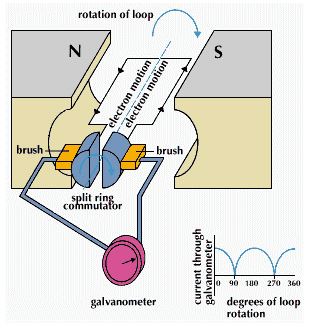
(iv) After half revolution, the sides AB and DC of the coil will interchange their positions. The side AB will come on the right hand side and start moving up whereas side DC will come on then the two commutator half rings R1 and R2 automatically change their contacts from one carbon brush to the other. Due to this change, the current keeps flowing in the same direction in the other circuits. The brush B1 always remaining positive terminal and brush B2 always remaining negative terminal of the generator. Thus, a D. C. generator supplies a current in one direction by the use of a commutator consisting of two, half-rings of copper. In the above discussion we have used the word D. C. generator everywhere. Please note that we can also write D. C. dynamo in place of D. C. generator.
Question : 38 When does an electric short circuit occur?
Answer :
Short circuiting
If the plastic insulation of the live wire and neutral wire gets torn, then the two wires touch each other. This touching of the live wire and neutral wire directly is known as short-circuiting. The current passing through the circuit formed by these wires is very large and consequently a high heating effect is created which may lead to fire.
Question : 39 What is the function of an earth wire? Why is it necessary to earth metallic appliances?
Answer :
To avoid electric shocks, the metal body of an electrical device is ‘earthed’. A wire called ‘earth wire’ is used to connect the metal body of the electrical device to the earth, which is at zero potential. In household circuits, we have three wires, the live wire, the neutral wire and the earth wire. One end of the earth wire is connected to the device and the other end of the wire is connected to the earth. We now say that the device is “earthed” or “grounded”. Usually the three wires are connected to a three-pin plug. The neutral wire or the earth connection carries the high current to the earth from the device and prevents an electric shock.
Multiple Choice Questions
Question : 1. A compass is to be placed near a bar magnet with unknown poles. Outside the magnetic field, the compass needle is pointing towards North as shown below:
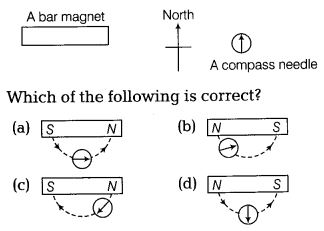
Answer :
(c) Magnetic field lines always point from North pole to South pole around the magnet. Thus, compass needle follows the path difference of magnetic field lines.
Question : 2. A bar magnet is broken into three parts X, Y and Z.

Answer :
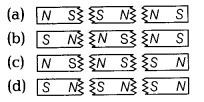
Question : 3. An unmagnetised iron bar is placed near the end of a bar magnet.
Which of the following diagram is correct?
Answer :
Mddle block 1
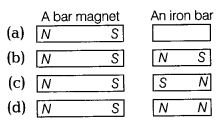
Question : 4. The diagram shows a current-carrying wire passing through the centre of a square cardboard.
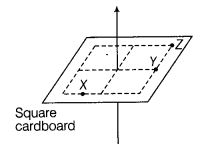
(a) equal at X, Y and Z
(b) stronger at Y than X, equal at Y and Z
(c) weaker at Y than Z, stronger at Y than Z
(d) stronger at Y than X, weaker at Z than X
Answer :
(d) The closer to the wire, the stronger is the magnetic field strength. Since, the magnetic field is circular. Y is the closest followed by X than Z.
Question : 5. A circular loop placed in a plane perpendicular to the plane of paper carries a current when the key is on.
The current as seen from points A and B (in the plane of paper and on the axis of the coil) is anti-clockwise and clockwise, respectively.
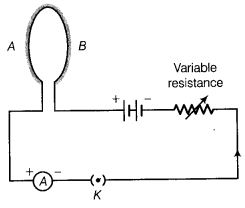
(a) A
(b) B
(c) A if the current is small and B if the current is large
(d) B if the current is small and A if the current is large [NCERT Exemplar]
Answer :
(a) The N-pole of the resultant magnet is on the face close to A because, the magnetic field lines enter in loop from B and come out from A. Also, as a matter of fact magnetic lines come out of the N-pole of magnet. Therefore, face close to A represents N-pole. The currents in A and B are same.
Question : 6. A bar magnet is used to pick up an iron nail. At which parts X, Y and Z is the easiest for the magnet to pick up the iron nail?
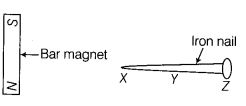
(b) AtY
(c) At Z
(d) It makes no difference
Answer :
(c) The region with the highest density of magnetic field lines has the greatest strength.
Question : 7. If the key in the arrangement as shown below is taken out (the circuit is made open) and magnetic field lines are drawn over the horizontal plane ABCD, the lines are [NCERT Exemplar]
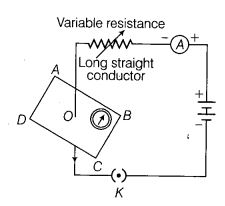
(b) elliptical in shape
(c) straight lines parallel to each other
(d) concentric circles near the point O but of elliptical shapes as we go away from it
Answer :
(c) When the key is taken out (the circuit is made open), no current flows through the wire, hence no magnetic field exists due to the conductor. The only magnetic field is due to Earth’s magnetic field and are straight lines parallel to each other. The horizontal component is directed from geographical South to geographical North on the horizontal plane ABCD.
Question : 8. Four metal rods are placed in turn inside the solenoid to attract paper clips. The table below gives the results of the experiment when current is switched on and off.
| Metalrod | When current is switched on, number of paper clips attracted | When current is switched off, number of paper clips still attracted |
|---|---|---|
| (a) | 1 | 0 |
| (b) | 20 | 2 |
| (c) | 35 | 0 |
| (d) | 35 | 30 |
Which rod would be the most suitable to use for the core of the solenoid in a circuit breaker?
Answer :
(c) The core of the solenoid in a circuit breaker must be made of a soft type magnetic material which can be strongly magnetised but does not retain induced magnetism.
Question : 9. Permanent magnets can be made using hard magnetic materials.
Which of the following is not the correct method to make permanent magnets?
(a) Using a bar magnet to stroke a steel bar
(b) Using two bar magnets to stroke a steel bar
(c) Placing a steel bar in a solenoid that connects to a DC supply
(d) Placing a steel bar in a solenoid that connects to an AC supply, then slowly withdrawing the steel bar away from the solenoid in West-East direction
Answer :
(d) The AC supply will mix up the direction of the magnetic domains. In fact, this is one of the methods to demagnetise magnets.
Question : 10. In the arrangement shown in figure, there are two coils wound on a non-conducting cylindrical rod. Initially, the key is not inserted. Then, the key is inserted and later removed. Then,
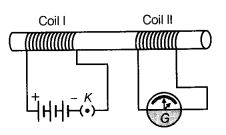
(b) there is a momentary deflection in the galvanometer but it dies out shortly and there is no effect when the key is removed.
(c) there are momentary galvanometer deflections that die out shortly, the deflections are in the same direction.
(d) there are momentary galvanometer deflections that die out shortly, the deflections are in opposite directions. Thus, the galvanometer shows momentary deflections in opposite directions. [NCERT Exemplar]
Answer :
(d) In the given arrangement, whenever an electric current through the first coil is changed, an emf is induced in the coil due to change in magnetic field lines which pass through the neighbouring second coil. When key is inserted and removed, then the magnetic field lines passing through second coil increases and decreases in two cases respectively. Therefore, the direction of current in two cases is opposite. Thus, the galvanometer shows momentary deflections in opposite directions.
Additional Questions
Question : 1 Define a solenoid. Compare the magnetic field produced by a solenoid with that of a bar magnet?
Answer :
A coil of many circular turns of wire wrapped in the shape of a cylinder, is called a solenoid. The magnetic field lines in a solenoid, through which current is passed, is very similar to that of a bar magnet. One end of the coil acts like a magnetic north pole, while the other acts like a south pole. The magnetic field produced by a long solenoid has all the properties of the field produced by a bar magnet.
Question : 2 Give one important advantage of AC over DC
Answer :
A.C can be stepped up and stepped down which means that the voltage can be increased or decreased. Hence it can be transmitted to long distances without much loss of energy. So A.C is preferred over D.C.
Question : 3 Give the circuit symbol for a fuse. Explain its importance in a circuit.
Answer :
A fuse is a very important device used for protecting electric circuits. It is a wire made out of a metal like tin or tin alloy having a very low melting point. When a high current flows through a circuit, the fuse wire gets heated or melts due to short circuiting or overloading. Hence the circuit is broken and the current stops flowing. This saves all the appliances of the circuit.
Mddle block 1
Question : 4 Give a note on Magnetism in Human beings.
Answer :
Whenever there is an electric current, there is a magnetic field. Even the extremely weak ion currents that travel along the nerve cells in our body produce magnetic fields. When we try to touch something, our nerves carry an electric impulse to the muscles we need to use. This impulse creates a temporary magnetic field. These fields are about one billionth as weak as the Earth’s field. Two main organs in the human body where the magnetic field produced is significant are heart and brain.
Question : 5 PQ is conductor × represents magnetic is ⊥ to the paper field and into the plane of the paper.
Answer :
Fleming’s left hand rule gives the direction of force experienced by a current carrying conductor kept in a magnetic field. According to it, when the thumb, first finger and second finger of the left hand are kept perpendicular to each other such that the first finger points towards the direction of magnetic field, the central finger is along the direction of current, then the thumb shows the direction of the force acting on the conductor.
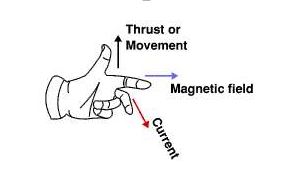
Question : 6 Define Electromotive force.
Answer :
The motion of a magnet, with respect to the coil, produces an induced potential difference. This induced potential difference is called electromotive force which sets up an induced electric current in the circuit. The motion of a magnet, with respect to the coil, produces an induced potential difference.
Question : 7 What is meant by earthing? Why should electrical appliances be earthed?
Answer :
The metal body of appliances like fridge, cooler, mixer etc. are connected to a an earth wire so that any leakage of current to the body of the appliance goes to the earth and does not give electric shock. This is called earthing. It is used as a safety measure in order to prevent electric shocks to the users.
Question : 8 What is a solenoid?
Answer :
A solenoid is a long cylindrical conductor coil, having a large number of turns of insulated copper wire.
Question : 9 State Fleming’s right Hand Rule. Give the principle, construction and working of the AC generator with a simple diagram. What modification will you suggest so that the output is DC
Answer :
According to Fleming’s right hand rule, when the thumb and the central finger of right hand are kept perpendicular to each other, the thumb shows the direction of motion of the conductor, the first finger the direction of magnetic field when the current induced is in the direction of central finger.
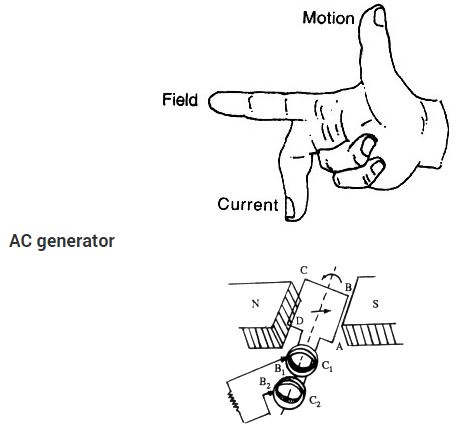
Principle: It works on the principle of electromagnetic induction. Induced current is produced, whenever current is produced.
Construction: A generator consists of mainly four parts, namely coil, magnets, slip rings and brushes just like an electric motor.
Coil: A large number of insulated copper wires wound on a rectangular frame.
Magnets: A large permanent magnet to provide a strong a magnetic field.
Slip rings: Two solid rings connected the two ends of the coil used to convey the current produced to outside circuit.
Brushes: Two carbon brushes remain in sliding contact with slip rings.
Working: The coil of the generator is rotated with the help of an axel. When coil rotates, it cuts through the magnetic field of the magnet. So a current is induced in the coil by electromagnetic induction. The direction of this current is given by Fleming’s right hand rule. As the coil turns clockwise, arm AB moves up and arm CD goes down. The direction of the current is from A to B and C to D. When after half rotation CD starts going up and AB starts coming down, the direction of the current in the coil also reverses. Now it is from D to C and from B to A. This alternating current with the help of slip rings which are in sliding contact with brushes B1 and B2 is given out to the circuit. Hence the current produced by the generator is alternating and such a generator is called AC generator. To get direct current in place of slip rings, split rings are used so that one brush is always in contact with the arm that goes downward. Then the current given out to the outer circuit is in the same direction. This type of generator is called DC generator.
Question : 10 How can you convert an A.C. into a D.C. generator?
Answer :
An A.C. generator can be converted into a D.C. generator by replacing the solid ring arrangement with split ring arrangement.
Question : 11 What is a magnetic field?
Answer :
The region around a magnet, in which the magnetic force of attraction and repulsion is felt, is called a magnetic field.
Question : 12 Distinguish between a solenoid and a bar magnet. Draw the magnetic lines for both
Answer :
The solenoid is a long coil containing a large number of close turns of insulated copper wire. The magnetic field produced by the current carrying solenoid is similar to the magnetic field produced by a bar magnet. A solenoid is used for making electromagnets.
Differences between a bar magnet and solenoid:
Bar magnet
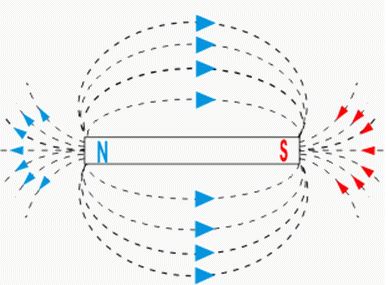
The strength of a bar magnet cannot be changed.
The polarity (North – South) of a bar magnet cannot be changed.
Solenoid
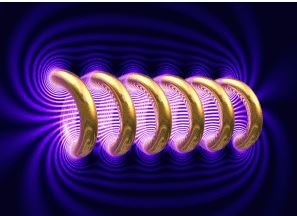
The strength of a solenoid can be changed by changing the number of turns in its coil or by changing the current passing through it.
The polarity of a solenoid can be changed by changing the direction of current in its coil.
Question : 13 What is electromagnetic induction? Explain how the movement of a magnet towards or away from a coil carrying a galvanometer produce current? Write the rule to find the direction of current in this above coil.
Answer :
Whenever the magnetic field through a conductor changes, and induced current and e. m. f. is set up in the conductor. This is known as electromagnetic induction.
Question : 14 Which effect of electric current is utilized in the working of an electric fuse?
Answer :
An electric fuse works on the heating effect of current.
Question : 15 What will you do if you see a person coming in contact with a live wire?
Answer :
Such a person should be provided with an insulated support of wood, plastic or rubber.
Question : 16 Name an instrument in which the directive property of a magnet is used.
Answer :
Compass needle makes use of the directive property of a magnet.
Question : 17 Name the elements of Earth’s magnetic field.
Answer :
The elements of Earth’s magnetic field are angle of dip, declination and horizontal component of earth’s magnetic field.
Question : 18 Explain, why two magnetic lines of force do not intersect?
Answer :
The magnetic lines of force do not intersect one another due to the fact that the resultant force on a north pole at any point can be only in one direction. But if the two magnetic lines of force intersect one another, then the resultant force on a north pole placed at the point of intersection will be along directions, which is not possible.
Question : 19 State the right hand thumb rule.
Answer :
If you hold the thumb, the forefinger and the centre finger of your right hand at right angles to one another. Adjust you hand in such a way that forefinger points in the direction of magnetic field, and the thumb points in the direction of motion of conductor, then the direction in which centre finger points, gives the direction of induced current in the conductor.
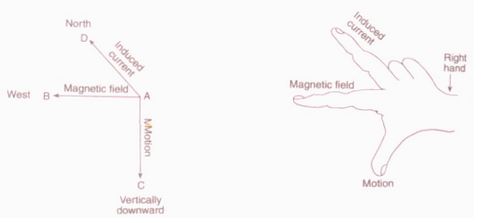
Question : 20 What is the cause of earth’s magnetism?
Answer :
Earth’s magnetism is due to the magnetic effect of current which is flowing in the liquid core at the centre of the earth.
Question : 21 How will you find out the direction of the magnetic field produced by current-carrying conductor?
Answer :
The direction of lines of force of the magnetic field produced by a straight wire carrying current is obtained by Maxwell’s right hand thumb rule. According to Maxwell’s right-hand thumb rule, “Imagine that the current carrying wire is in the right hand so that the thumb points in the direction of current, then the direction in which the fingers encircle the wire gives the direction of magnetic lines of force around the wire.
Imagine a current carrying wire AB in which the current is flows vertically upwards. To find out the direction of magnetic lines of force produced by this current, we imagine the wire AB to be held in the right hand, so that the thumb points in the direction of current towards A. Now, the direction in which the fingers are folded gives the direction of the lines of force. In this case the fingers are folded in the anti-clockwise direction, so the magnetic lines of force are also in the anti-clockwise direction.
Question : 22 What type of core should be put inside a current-carrying solenoid to make an electromagnet?
Answer :
A soft iron core is placed inside a solenoid to make an electromagnet. When a soft iron core is placed inside a solenoid, then the strength of the magnetic field becomes very large because the iron core gets magnetized by induction. This combination of a solenoid and a soft iron core is called an electromagnet.
Question : 23 Distinguish between a bar magnet and an electromagnet.
Answer :
Bar Magnets
The bar magnet is a permanent magnet.
It produces a comparatively weak force of attraction.
The strength of a bar magnet cannot be changed.
The polarity of a bar magnet is fixed and cannot be changed.
Electromagnets
An electromagnet is a temporary magnet.
It produces a very strong magnetic force.
The strength of an electromagnet can be changed by changing the number of turns in its coil or by changing the current passing through it.
The polarity of an electromagnet can be changed by changing the direction of current in its coil.
Question : 24 State the composition of the alloy called nipermag? Give an important use of this alloy.
Answer :
Nipermag is an alloy of iron, nickel, aluminium and titanium. Permanent magnet of this alloy is more stronger than those made of ordinary steel. Hence it used in microphones and loudspeakers.
Question : 25 Derive the formula for the force acting on a charged particle moving in a magnetic field.
Answer :
The force acting on a current-carrying conductor placed in a magnetic field is,
F = B × I × L
The current I is the rate of flow of charge.
Now, if a charge Q flows in time t then the current I = Q/t. Hence substituting for I in
the above equation, we get,
F = (B × Q × L)/t
Suppose the particle carrying the charge Q travels a length L in time t, then the velocity
v = L/t. So substituting this value, we get
Force on moving charge F = B × Q × v.
Question : 26 How does alternating current differ from the direct current?
Answer :
If current always flows in the same direction, it is called a direct current. The current, which we get from the cell or a battery, is a direct current because it always flows in the same direction. The positive and negative polarity of a direct current is fixed. If the current changes direction after regular intervals of time, it is called alternating current. Most of the power stations in India generate alternating current. The alternating current produced in India changes its direction every 1/100 second. Thus, the positive and negative polarity of an alternating current is not fixed.
Question : 27 Give two reasons why different electrical appliances in a domestic circuit are connected in parallel.
Answer :
(i) If one of the appliances is switched off or gets fused, there is no effect on the other appliances and they keep on operating.
(ii) The same voltage of the main line is available for all electrical appliances.
Question : 28 Why is a fuse wire made of a tin-lead alloy and not copper?
Answer :
A fuse wire is made of tin alloy because it has low melting point, so that it may melt easily, whereas a copper wire cannot be used as a fuse wire because it has a high melting point due to which it will not melt easily when a short circuit takes place.
Question : 29 Explain the principle and working of an electric motor with the help of a diagram. What is the function of a split ring commutator?
Answer :
An electric motor converts electrical energy into mechanical energy. It works on the principle that – a current carrying conductor placed in a magnetic field experiences a force.
Following are the essential parts of an electric motor.
(i) Coil: It is a rectangular coil of insulated copper wire having large number of turns.
(ii) A large permanent magnet provides strong magnetic field between its pole pieces. The coil rotates between these pole pieces.
(iii) Split rings: The two ends of the coil are connected to two split rings, which are two halves of a slip rings.
(iv) Brushes: Two carbon brushes keep in sliding contact with split rings.
Working:
When a current is passed through the coil, the direction of current in AB and CD is in opposite direction but both are perpendicular to magnetic field. Therefore, by Fleming’s left hand rule AB arm of the coil experiences an upward force and CD arm experiences a downward force. These two forces being equal and opposite to each other form a couple which rotates the coil. Arms BC and DA are parallel to the field and the force on them is zero. The forces, on AB and CD turn the coil in clockwise direction. After half revolution, the split rings change their position. Now S2 is in contact with brush B1 and S1 is in contact with B2. So the direction of current in the coil reverses. Therefore, AB now experiences downward force and CD upward force. The couple now acting on the coil again moves it in clockwise direction. Due to the function of split ring commutator and brushes, coil continues to turn in clockwise direction.
Split ring commutator changes direction after every half rotation, so that the direction of current going in the coil also reverses and the arm of the coil which goes up in the first half, goes down in second half. As a result, the coil continues to rotate in one direction. Anything connected to the axis of the coil also rotates. So, the electrical energy given to the coil changes into mechanical energy.
Question : 30 With the help of a labelled diagram, explain the working of an A.C. generator.
Answer :
“A. C. generator”
means “Alternating Current generator”. That is, an A. C. generator produces alternating current, which alternates (changes) in polarity continuously. We will now describe the construction an working of the A. C. generator or A. C. dynamo.
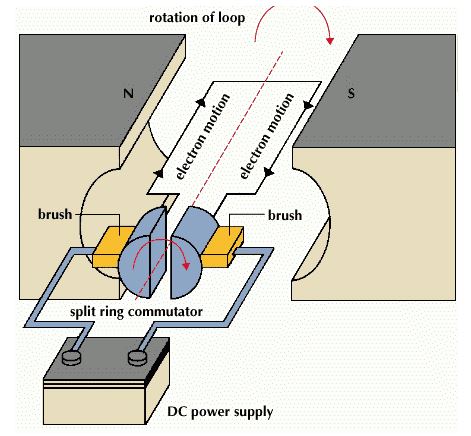
A simple A. C. generator consists of a rectangular coil ABCD that can be rotated rapidly between the poles N and S of a strong horseshoe type magnet M. The coil is made of a large number of turns of insulated copper wire. The ends A and D of the rectangular coil are connected to two circular pieces of copper metal called slip rings R1 and R2. As the slip rings R1 and R2 rotate with the coil, the two pieces of carbon called brushes, B1 and B2, keep contact with them. So, the current produced in the rotating coil can be tapped out through slip rings into the carbon brushes. From the carbon brushes B1 and B2 we take the current into various electrical appliances like radio, T. V., electric iron, bulbs, etc. But in this figure, we have shown only a galvanometer G connected the two carbon brushes.
Working of an A. C. generator
Suppose that the generator coil ABCD is initially in the horizontal position. Again suppose that he coil ABCD is being rotated in the anticlockwise direction between the poles N and S of a horseshoe type magnet.
(i) As the coil rotates in the anticlockwise direction, the side AB of the coil moves down cutting the magnetic lines of force near the N-pole of the magnet, and side CD moves up, cutting the lines of force near the S-pole of the magnet. Due to this, induced current is produced in the sides AB and DC of the coil. On applying Fleming’s right hand rule to the side AB and DC of the coil, we find that the currents are in the direction B to A and D to C respectively. Thus, the induced currents in the two sides of the coil are in the same direction, and we get an effective induced current in the direction BADC.
(ii) After half revolution, the sides AB and DC of the coil will interchange their positions. The side AB will come on the right hand side and DC will come on the left side. So, after half a revolution, side AB starts moving up and side DC starts coming down. As a result of this, the direction of induced current in each side of the coil is reversed after half a revolution. Since the direction of induced current in the coil is reversed after half revolution so the polarity (positive and negative) of the two ends of the coil also changes after half revolution. The end of coil which was positive in the first half of rotation becomes negative in the second in the second half. And the end which was negative in the first half revolution becomes positive in the second half of revolution. Thus, in 1 revolution of the coil, the current changes its direction 2 times.
The alternating current (A. C.) produced in India has a frequency of 50 Hz. That is, the coil is rotated at the rate of 50 revolutions per second. Since in 1 revolution of coil, the current changes its direction 2 times, so in 50 revolutions of coil, the current changes its direction 2 × 50 = 100 times. Thus, the A. C. supply in India changes its direction 100 times in 1 second. Another way of saying this is that the alternating current produced in India changes its direction every 1/100 second. That is, each terminal of the coil is positive (+) for 1/100 of a second and negative (-) for the next 1/100 of a second. This process is repeated again and again with the result that there is actually no positive and negative in an A. C. generator. We will now describe why the direction of induced current in the coil of an A. C. generator changes after every half revolution of the coil.
After every half revolution, each side of the generator coil starts moving in the opposite direction in the magnetic field. The side of the coil which was initially moving downwards in a magnetic field, after half revolution, it starts moving in opposite direction – upwards. Similarly the side of coil which was initially moving upwards, after half revolution, it starts moving downwards. Due to the change in the direction of motion of the two sides of the coil in the magnetic field after every half revolution, the direction of current produced in them also changes after every half revolution.
Question : 31 Explain the principle, construction and working of a DC Motor.
Answer :
“D. C. generator”
means “Direct Current generator”. That is, a D. C. generator produces direct current and not alternating current. We will now describe the construction and working of D. C. generator or D. C. Dynamo.
Construction of a D. C. generator
A simple D. C. generator consists of a rectangular coil ABCD which cab be rotated rapidly between the poles N and S of a strong horse-shoe type magnet M. The generator coil is made of a large number of turns of insulated copper wire. The two ends of the coil are connected to the two copper half rings (or split rings) R1and R2 of a commutator. There are two carbon brushes B1 and B2 which press lightly against the two half rings. When the coil is rotated, the two half rings R1 and R2 touch the two carbon brushes B1 and B2 one by one. So the current produced in the rotating coil can be tapped out through the commutator half rings into the carbon brushes. From the carbon brushes B1 and B2, we can take the current into the various electrical appliances like radio, T. V., electric iron, bulbs, etc. But in this figure, we have shown only a galvanometer G connected between the two carbon brushes. The galvanometer is a current detecting and current measuring instrument.
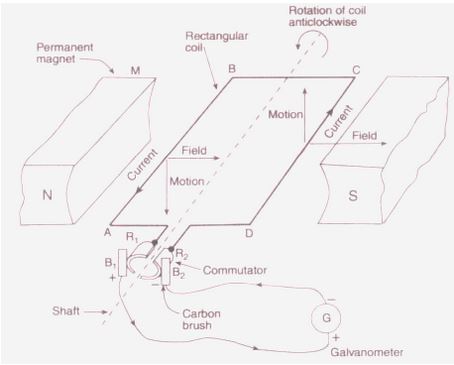
Suppose that the generator coil ABCD is initially in the horizontal position. Again suppose that he coil ABCD is being rotated in the anticlockwise direction between the poles N and S of a horseshoe type magnet.
As the coil rotates in the anticlockwise direction, the side AB of the coil moves down cutting the magnetic lines of force near the N-pole of the magnet, and side DC moves up, cutting the lines of force near the S-pole of the magnet. Due to this, induced current is produced in the sides AB and DC of the coil. On applying Fleming’s right hand rule to the side AB and DC of the coil we find that the currents in them are in the direction B to A and D to C respectively. Thus, the induced currents in the two sides of the coil are in the same direction, and we get an effective induced current in the direction BADC. Due to this the brush B1becomes a positive (+) pole and brush B2 becomes negative (-) pole of the generator.
After half revolution, the sides AB and DC of the coil will interchange their positions. The side AB will come on the right hand side and start moving up whereas side DC will come on then the two commutator half rings R1 and R2 automatically change their contacts from one carbon brush to the other. Due to this change, the current keeps flowing in the same direction in the other circuits. The brush B1 always remaining positive terminal and brush B2 always remaining negative terminal of the generator. Thus, a D. C. generator supplies a current in one direction by the use of a commutator consisting of two, half-rings of copper. In the above discussion we have used the word D. C. generator everywhere. Please note that we can also write D. C. dynamo in place of D. C. generator.
Question : 32 What is a fuse wire? What is the advantage and disadvantage of using a thick fuse wire?
Answer :
A fuse is a very important device used for protecting electric circuits. It is a wire made out of a metal like tin or tin alloy having a very low melting point. When a high current flows through a circuit, the fuse wire gets heated or melts due to short-circuiting or overloading. Hence the circuit is broken and the current stops flowing. This saves all the appliances of the circuit.
Question : 33 The device used for producing current is called a,
(i) Generator
(ii) Voltmeter
(iii) Ammeter
(iv) Galvanometer.
Answer :
(i) Generator. The other devices are measuring instruments.
Question : 34 What are magnetic field lines? How is the direction of a magnetic field at a point determined? Mention two important properties of the magnetic field lines.
Answer :
The space surrounding a magnet in which magnetic force is exerted, is called a magnetic field. Magnetic field lines are the lines that are drawn at every point indicating the direction in which a north pole would move if placed at that point. They are determined by placing an imaginary hypothetical north pole at that point and finding the direction in which it would move due to the magnetic field at that point. A compass needle gets deflected when placed near a magnet due to the magnetic force exerted by the magnet on it.
Mddle block 1
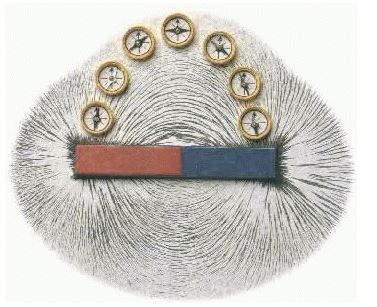
(i) The tangent drawn at any point on the field line indicates the direction in which a north pole would move if placed at that point.
(ii) The relative strength of the field is proportional to the degree of closeness of the lines. The more clustered they are, the stronger the field in that region.
(iii) The magnetic field lines never intersect. This is because a pole can move only in zone direction and if the lines intersect they would have to move in two direction simultaneously which is impossible.
Question : 35 Draw a rough sketch of the pattern of field lines due to a
(i) current flowing into a circular coil and
(ii) solenoid carrying current.
Answer :
(i) current flowing into a circular coil and
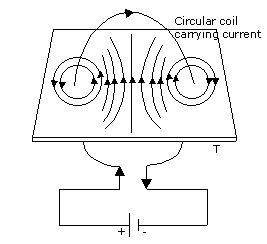
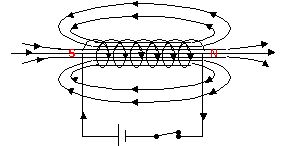
Question : 36 State the rule to determine the direction of a
(i) magnetic field produced around a straight conductor-carrying current,
(ii) force experienced by a current-carrying straight conductor placed in a magnetic field which is perpendicular to it, and
(iii) current induced in a coil due to its rotation in a magnetic field.
(iv) Current induced in a circuit by the changing magnetic flux due to the motion of a magnet.
Answer :
(i) The direction of a magnetic field produced around a current-carrying conductor can be obtained by using Maxwell’s right-hand thumb rule. It states that “if you hold the current carrying wire in your right hand with your thumb pointing in the direction of the magnetic field then the fingers will wrap around the conductor in the direction of the magnetic field lines due to the conductor”.
(ii) The direction of the force experienced by a straight conductor carrying current placed in a magnetic field is determined using Fleming’s left hand rule. It states that “if you stretch the forefinger, the central finger and the thumb of your left hand mutually perpendicular to each other, the forefinger points in the direction of the magnetic field and the central finger points in the direction of current, and the thumb points in the direction of force acting on the conductor”.
(iii) The direction of the current induced in a circuit by changing the magnetic flux due to motion of a conductor is given by Fleming’s right hand rule. It states that “if you hold the forefinger, the central finger and the thumb of your right hand mutually perpendicular to each other, the forefinger indicates the direction of the changing field / flux, the thumb indicates the direction of motion of the conductor and the middle finger gives the direction of the induced current”. This phenomenon is called electromagnetic induction.
Question : 37 On what factors does the force experienced by a current–carrying conductor placed in a uniform magnetic field depend?
Answer :
The force on a current carrying conductor placed in a magnetic field is given by the Fleming’s left hand rule.
F = B I L
Where F is the force on the conductor
B is the magnitude of the uniform magnetic field
I is the current in the conductorL is the Length of the current carrying wire.
Therefore from the above formula, force is directly proportional to the magnitude of the field, current in the wire and the length of the wire.
Question : 38 Explain the principle and working of an electric motor with the help of a diagram.What is the function of a split–ring commutator ?
Answer :
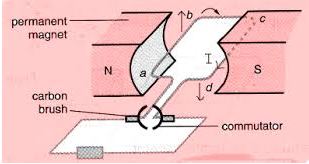
Principle
An electric motor is based on the fact that when a current carrying conductor is placed in a magnetic field the conductor experiences a force which is given by Fleming’s Left Hand Rule. For example, when a rectangular coil is placed in the magnetic field and current is passed through it, a torque acts on the coil, which rotates it continuously. When the coil rotates, the shaft attached to it also rotates and therefore the electrical energy supplied to the motor is converted into the mechanical energy of rotation.
An electrical motor consists of a rectangular coil ABCD of insulated copper wire, wound on a soft iron core called armature. The coil is mounted between the poles of a magnet in such a way that it can rotate between the poles N and S. The two ends of the coil are soldered to the ends of a commutator whose main function is to reverse the direction of the current flowing through the coil every time the coil just passes the vertical position during its revolution.
Working
Suppose the coil ABCD is initially at a horizontal position. When the switch is in ON position the current enters the coil through the carbon brushes and the half ring ‘A’ of the commutator. The current flows in the direction DCBA and leaves via the half ring ‘B’. In the side PQ of the coil, the direction is from Q to P towards the south and the direction of the magnetic field is from the N to S pole towards the east. So, by applying Fleming’s left hand rule, we find that it will experience a force in upward direction. Similarly, the side SR of the coil will experience a downward force. Thus we have two parallel wires experiencing forces in opposite directions. They form a couple tending to rotate the coil in the anticlockwise direction. When the coil goes beyond the vertical position, the two commutator half rings automatically changes contact from one brush to the other. This reverses the direction of current through the coil which, in turn, reverses the direction of forces acting on the two sides of the coil. The sides of the coil are interchanged, but rotate in the same anticlockwise direction. This process is repeated again and again and the coil continues to rotate as long as the current is passing.
Question : 39 A coil of copper wire is connected to a galvanometer. What would happen if a bar magnet is
(i) Pushed into the coil with its north pole entering first?
(ii) Pulled out of the bar magnet?
(iii) Held stationary inside the coil?
Answer :
(i) A deflection is observed in the galvanometer due to the induced current because of the changing magnetic flux (increasing) through the turns of the coil connected to the galvanometer.
(ii) A deflection is again observed in the galvanometer, as when it is pulled out, the flux linked with the coil due to the bar magnet decreases. Hence a current flows in the coil to reduce the change in flux. The deflection can be observed in the opposite direction as compared with the previous case.
(iii) No deflection is observed in the galvanometer. The flux linked with the coil due to the magnetic field is at a constant. Hence no current is induced due to the bar magnet.
Question : 40 Draw a labelled diagram to explain the principle underlying the working of an electric generator.
Answer :
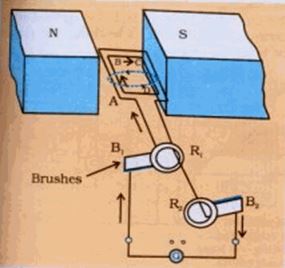
Question : 41 What is the function of an earth wire? Why is it necessary to earth the metallic appliances?
Answer :
To avoid electric shocks, the metal body of an electrical device is ‘earthed’. A wire called ‘earth wire’ is used to connect the metal body of the electrical device to the earth, which is at zero potential. In household circuits, we have three wires, the live wire, the neutral wire and the earth wire. One end of the earth wire is connected to the device and the other end of the wire is connected to the earth. We now say that the device is “earthed” or “grounded”. sually the three wires are connected to a three-pin plug. The neutral wire or the earth connection carries the high current to the earth from the device and prevents an electric shock.
Question : 42 Explain what is short-circuiting and overloading in an electric supply.
Answer :
Short circuiting
If the plastic insulation of the live wire and neutral wire gets torn, then the two wires touch each other. This touching of the live wire and neutral wire directly is known as short-circuiting. The current passing through the circuit formed by these wires is very large and consequently a high heating effect is created which may lead to fire.
Overloading
The current flowing in domestic wiring at a particular time depends on the power ratings of the appliances being used. If too many electrical appliances of high power rating are switched on at the same time, they draw an extremely large current from the circuit. This is known as overloading. Due to this large current flowing through them, the copper wires of household wiring get heated to a very high temperature and may lead to fire.
Question : 43 Describe an experiment to illustrate the action of an electric fuse.
Answer :
Take a thin fuse wire made of tin or tin-alloy having low melting point. Place this fuse wire on the porcelain fuse grip and insert the grip into the fuse holder. Now switch on all the electrical appliances of high power rating like electric iron, water heater, air conditioner, etc.,. Since the melting point of the fuse wire is much lower, it melts and breaks the circuit.


